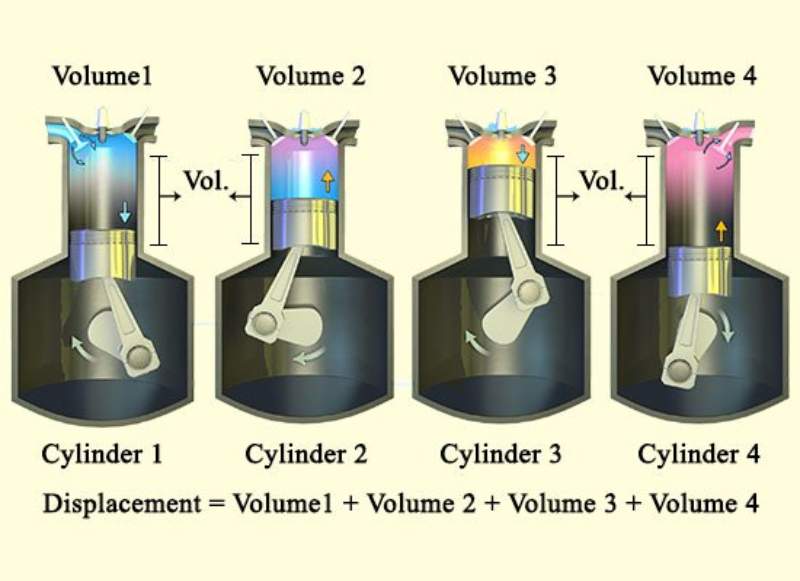What Are Liters In An Engine

Alright, let's dive into the heart of your engine and talk about liters. When we say an engine is, say, a "2.0-liter" or a "5.7-liter," we're talking about its displacement – the total volume swept by all the pistons inside the cylinders during one complete engine cycle. Understanding engine displacement is crucial, whether you're planning performance modifications, troubleshooting engine issues, or simply want a deeper appreciation for how your car works.
Key Specs and Main Parts
Think of your engine as an air pump. The bigger the pump, the more air (and fuel) it can move, potentially leading to more power. Here's the breakdown:
- Cylinder Bore: This is the diameter of each cylinder, typically measured in millimeters (mm) or inches. A larger bore generally allows for bigger valves and better airflow.
- Piston Stroke: This is the distance the piston travels from its highest point (Top Dead Center – TDC) to its lowest point (Bottom Dead Center – BDC). Longer strokes tend to produce more low-end torque.
- Number of Cylinders: Common configurations include inline-4 (I4), V6, V8, and flat-4 (boxer) engines. The more cylinders, the smoother the engine *can* be (although balance also plays a role), and potentially the more displacement you can achieve.
- Combustion Chamber: This is the space at the top of the cylinder where the air/fuel mixture is compressed and ignited. Its volume is critical for determining the engine's compression ratio.
The relationship between these components is what determines the overall engine displacement.
Calculating Engine Displacement
The formula for calculating the displacement of a single cylinder is:
Volume (single cylinder) = π * (Bore / 2)² * Stroke
Where:
- π (Pi) is approximately 3.14159
- Bore is the cylinder bore diameter
- Stroke is the piston stroke length
To get the total engine displacement, you multiply the single-cylinder volume by the number of cylinders.
Total Displacement = Volume (single cylinder) * Number of Cylinders
For example, let's say we have a four-cylinder engine with a bore of 86mm and a stroke of 86mm. First, calculate the single-cylinder volume:
Volume (single cylinder) = 3.14159 * (86 / 2)² * 86 = 499.7 cm³ (approximately)
Then, multiply by the number of cylinders:
Total Displacement = 499.7 cm³ * 4 = 1998.8 cm³
Since 1 liter is equal to 1000 cm³, this engine would be marketed as a 2.0-liter engine.
How It Works
During the 4-stroke combustion cycle (intake, compression, combustion, exhaust), the piston moves down in the cylinder, drawing in air and fuel. On the compression stroke, the piston moves *up*, compressing the mixture. The amount the mixture is compressed depends on the volume of the cylinder at BDC compared to the volume at TDC (the combustion chamber). This compression ratio is key to efficient combustion and power output.
The *displacement* represents the "size" of each intake and exhaust gulp your engine takes. A larger displacement means each cylinder can draw in more air/fuel mixture, leading to more potential energy released during combustion.
Real-World Use – Basic Troubleshooting Tips
Engine displacement doesn't directly cause problems, but understanding it can help diagnose issues. Here's how:
- Performance Expectations: Knowing the displacement helps you set realistic performance goals. Don't expect a 1.6-liter engine to perform like a 5.0-liter engine without significant modifications.
- Fuel Economy: Generally, larger displacement engines consume more fuel, especially under heavy load. Comparing your fuel economy to published figures for your engine size can highlight potential problems (e.g., leaking injectors, faulty O2 sensors).
- Engine Swaps: When considering an engine swap, displacement is a major factor. A significantly larger engine may not fit properly or be compatible with your vehicle's other systems (transmission, cooling, etc.).
- Compression Testing: A compression test measures the pressure inside each cylinder at TDC. Significantly low compression in one or more cylinders suggests problems like worn piston rings, damaged valves, or a blown head gasket. Understanding how the *displacement* factors into theoretical compression pressure helps interpret the results.
If you notice a sudden drop in performance, increased fuel consumption, or unusual engine noises, a compression test is a good starting point. Uneven compression across cylinders is a strong indicator of internal engine damage.
Safety – Highlight Risky Components
Working on any engine component involves risks. Here are some key safety considerations:
- High Temperatures: The engine block, cylinder head, and exhaust system get extremely hot. Always allow the engine to cool completely before working on it.
- Rotating Parts: The crankshaft, connecting rods, and pistons move at high speeds. Never start the engine with the valve cover or oil pan removed.
- Fuel System: The fuel system contains highly flammable gasoline under pressure. Disconnect the battery and take precautions to prevent sparks when working on the fuel system. Properly depressurize the fuel system before disconnecting any lines.
- Electrical System: The ignition system generates high voltage. Avoid contact with spark plug wires or the ignition coil while the engine is running or the ignition is on.
- Sharp Edges: Many engine components have sharp edges. Wear gloves to protect your hands.
- Heavy Components: Engine components like the cylinder head and engine block are heavy. Use proper lifting equipment to avoid injury.
Always consult a qualified mechanic if you are unsure about any aspect of engine repair or modification.
In Conclusion
Understanding engine liters and displacement gives you a solid foundation for comprehending how your engine produces power. It's a crucial piece of the puzzle for both simple maintenance and more complex modifications. It will allow you to choose the right engine, modify your existing engine or troubleshoot more efficiently.
We have a detailed diagram of a typical engine with labeled components and calculations available for download. This visual aid can further enhance your understanding of engine displacement and its relationship to other engine parameters. You can find the link [link to file - Placeholder, implement appropriately].
